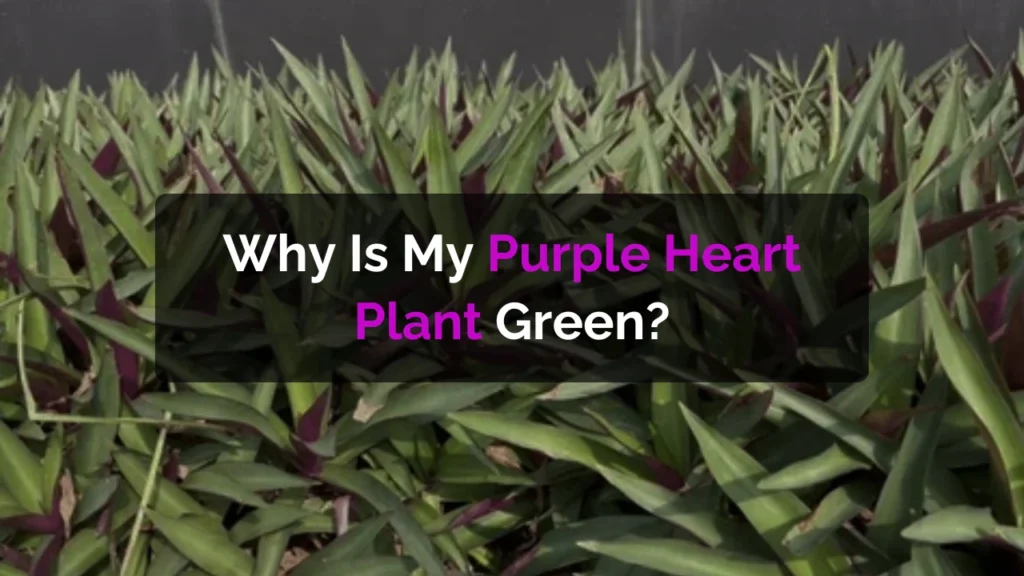If your purple heart plant is turning green instead of its usual vibrant purple, it’s often a sign that something in its environment has changed. This plant is known for its stunning purple leaves, but under certain conditions, it can lose its color and appear green. Understanding the causes can help you bring back its bold hue and keep your plant thriving.
1. Lack of Sunlight
The most common reason your purple heart plant is turning green is insufficient sunlight. These plants need bright, indirect light or even some direct sunlight to maintain their signature purple shade. When grown in low light or shade, the plant produces less anthocyanin pigment, which is responsible for its purple color. As a result, the leaves turn greener as the green chlorophyll becomes more dominant.
Solution:
Place your plant in a bright location, such as near a sunny window or outdoors where it gets a few hours of morning sun. Avoid harsh afternoon sunlight, which can burn the leaves.
2. Overwatering or Poor Drainage
Too much water can also affect the plant’s color and health. Overwatering leads to root rot, which weakens the plant and prevents it from producing pigments properly.
Solution:
Allow the top inch of soil to dry before watering again. Use a well-draining potting mix and a container with drainage holes to avoid soggy soil.
3. Nutrient Imbalance
A lack of nutrients, especially phosphorus and potassium, can make the leaves look dull or faded. Healthy soil helps maintain the plant’s vibrant color and growth.
Solution:
Feed your purple heart plant with a balanced liquid fertilizer once a month during the growing season (spring and summer). Avoid over-fertilizing, as that can damage the roots.
4. Temperature and Humidity Changes
Purple heart plants prefer warm, stable temperatures and moderate humidity. Exposure to cold drafts, air conditioning, or sudden temperature drops can stress the plant, leading to a loss of purple color.
Solution:
Keep your plant in a warm area (ideally between 60–85°F) and away from cold windows or vents. Mist the leaves occasionally to maintain humidity if you live in a dry climate.
5. New Growth Appears Green
It’s normal for new leaves to emerge green before turning purple as they mature. This is part of the plant’s natural growth cycle.
Solution:
Be patient and ensure your plant gets enough sunlight. As the leaves age and receive more light, they’ll deepen to a rich purple color.
6. Indoor vs. Outdoor Conditions
Purple heart plants grown indoors often appear greener than those grown outdoors. Indoor light intensity is typically lower, even near bright windows.
Solution:
If possible, move your plant outdoors during the warmer months to give it access to stronger natural light. This can help enhance the purple pigment production.
Final Thoughts
If your purple heart plant has turned green, it’s usually due to low light, overwatering, or environmental stress. By adjusting its care routine—especially improving light exposure—you can help your plant regain its beautiful purple color. Consistent attention to sunlight, soil, and watering will keep it healthy and vibrant all year round.
FAQs
Can a purple heart plant turn purple again after turning green?
Yes. Once the plant gets more sunlight and proper care, its leaves will gradually regain their purple color.
How much light does a purple heart plant need?
It thrives in bright, indirect sunlight and can tolerate some direct morning sun. Low light makes it lose its purple tone.
Should I prune my purple heart plant if it turns green?
Yes, pruning encourages new growth, which can develop a deeper purple shade under good light conditions.
Why are my purple heart plant’s leaves fading?
Fading leaves may result from too little light, overwatering, or a lack of nutrients. Check and adjust these care factors.
Can I grow my purple heart plant outside?
Yes, it grows beautifully outdoors in warm climates. Just protect it from frost and provide bright light for strong purple color.





